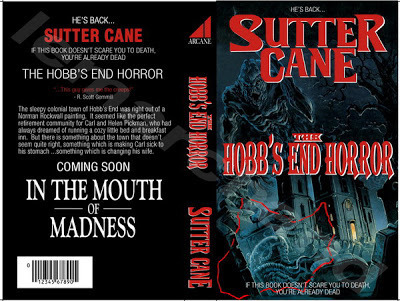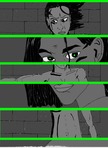M.R. Gott's Blog, page 13
April 5, 2013
Graphic, But Not Exploitative A contemplation on depictions of violence My Guest post at Leigh M. Lane's Cerebralwriter.com
If you ever wondered my thoughts on fictional violence now's your chance, click below to jump to Cerebral Writer...
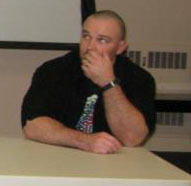

Published on April 05, 2013 13:02
April 1, 2013
John Dies at the End
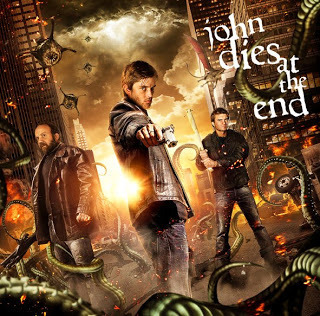
A decade after Bubba Ho-Tep Don Coscarelli is back with another feature based off a cult author’s work that masterfully blends humor and horror.
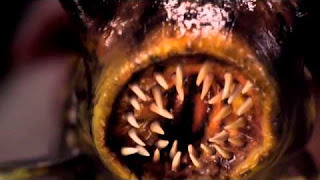
John Dies at the End follows our hero Dave Wong and his buddy John as they are forced to fight off and interdimensional invasion. The invaders are using a new drug known as soy sauce to take over the physical beings of those who take it, allowing them to be controlled by the invaders. The soy sauce affects everyone differently, so that no encounter with a possessed person is ever the same.
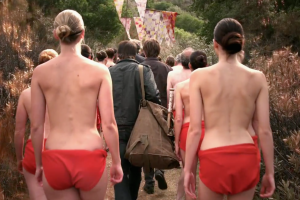
Coscarelli’s film captures the spirit of David Wong’s book incredibly well, and he has great success mixing the horror and comedy elements. There are moments in the film that are both genuinely creepy and laugh out loud funny. Don Coscarelli’s infuses the film with a trippy visual flair that adds energy even to some simpler scenes of dialogue. It also creates a sense that at no point is anyone truly safe. The cast is incredibly strong overall with relative new comers Chase Williamson and Rob Mayes giving great grounded performances to balance the absolute chaos that moves around them. Paul Giamatti plays a newspaper reporter who interviews Dave, and this is the narrative device used to move the story forward. While this creates a choppy sense of pace at times, it also allows Don Coscarelli who also wrote the screen play to stream line Wong’s novel. For diehard fans of the book this means great chunks of the novel are just missing. There is some voice over work by Chase Williamson as Dave, however most of the humorous elements have been cut, and the voice over is used almost exclusively to move the plot forward.
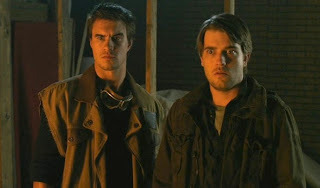
I stated at times the books comes to a grinding halt, and at 100 minutes these slower elements are nowhere to be found, but many action set pieces are also absent, including my favorite one. In keeping with the spirit of the book , Don Coscarelli still includes the existential humor that helped to define Wong’s book.
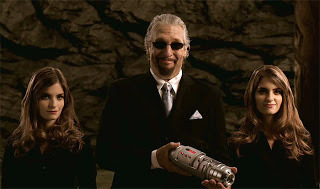
John Dies at the End is a trippy, creepy existential comedy. Some fans of the book, will probably be let down by some of the alterations made to make the story more filmable, especially for a smaller budget feature. Despite this, the movie is wholly enjoyable to those of us with odder sensibilities and I can say I enjoyed every frame of Don Coscarelli’s newest film with a stupid grin on my face. (Review previously posted at Ravenous Monster.com)
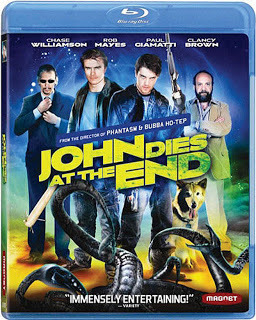 Special Features:Audio commentary with director Don Coscarelli, producer Brad Baruh, Chase Williamson and Rob Mayes Deleted scenes Behind the Scenes featurette Monster Design featurette Fangoria interviews with Director Don Coscarelli and Paul Giamatti AXS TV: A Look at John Dies at the End Trailers
Special Features:Audio commentary with director Don Coscarelli, producer Brad Baruh, Chase Williamson and Rob Mayes Deleted scenes Behind the Scenes featurette Monster Design featurette Fangoria interviews with Director Don Coscarelli and Paul Giamatti AXS TV: A Look at John Dies at the End Trailers
Published on April 01, 2013 17:01
March 31, 2013
Do You Read Sutter Cane?
Published on March 31, 2013 17:16
March 24, 2013
MY SHORT STORY DADDY'S GOT YOU WILL BE AVAILABLE IN...TALES OF OBSCENITY #1 LIMITED HARDCOVERS
We are very happy to announce that the Special Hardcover Limited Editions of issue #1 are now available to pre-order! The pre-order window will be open for 60 days and will close May 22nd, 2013. The print run for the Special Limited Signed & Numbered Edition will then be set and no more copies can be ordered. So make sure you order your copy today! Don't leave it in case you forget and miss the pre-order window!
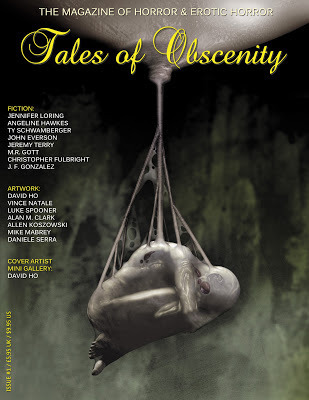
Please Note: The Signed & Lettered Edition is limited to only 52 copies and once they're gone, they're gone! If you'd like one of these very collectable editions please make sure you order now before they sell out.
People who pre-order the Limited Edition Hardcovers will be the first to hear about (and be able to order) any other issues we publish.
The Hardcover Special Limited Signed & Numbered Edition is signed & numbered by the editor and will feature exclusive original artwork by Luke Spooner on the limitation page created especially just for this edition, and will never appear anywhere else. These copies are available for only £29.95 with FREE worldwide shipping*!
The Hardcover Special Limited Signed & Lettered Edition is signed & lettered by the editor and available in only 52 copies. This edition will also feature exclusive original artwork by Luke Spooner (different from the numbered edition) on the limitation page created especially just for this lettered edition, and will also never appear anywhere else. These copies are available for only £49.95 with FREE worldwide shipping*!
* FREE worldwide shipping: UK is by 1st Class Post and overseas is by Surface Mail. Please Note: Surface Mail can take between 4 to 8 weeks for delivery. We also offer overseas customers the option of paying extra for Airmail Shipping (just £5.00 more), but we love FREE shipping so we thought it would be great to offer it to our customers!
Both of these very collectable hardcover editions will be printed in FULL COLOUR throughout and will feature exclusive original artwork on the limitation page. The books are case laminate, which is basically a hardcover book without a dust jacket. The cover artwork is printed directly onto the hardcover case. They will be printed using Premium Colour high-quality printing on 70#, 378 PPI White paper, as opposed to the Standard Colour printing of the magazine which is printed on 50#, 512 PPI White paper. So the paper stock for the hardcover editions is thicker and better quality and the interior full colour printing quality is much superior. The magazine print and production quality is excellent but the quality of the hardcovers will be much, much higher!
PLEASE NOTE: Copies are allocated on a first-come first-served basis. You are very welcome to request a specific number or letter and we will try our best to accommodate. We're sorry but we cannot guarantee to allocate the copy/copies you ask for.
These very collectable editions are exclusively available to order from SST Publications. Please visit the link below to the page where you can see the cover art, the full table of contents and also buy now using PayPal.
http://sstpublications.co.uk/sst/Magazines/Tales-of-Obscenity-1-Hardcovers.html
We estimate that the publication date for these special hardcover editions will be around August 2013.
We are very sorry but:We cannot offer any wholesale discounts to booksellers on these because of the very limited print run. But booksellers are more than welcome to order copies at full price.
We cannot accept any discount vouchers or codes on these hardcover editions.
The Hardcover Editions of the magazine are not included in the magazine Lifetime Subscriptions.
PLEASE NOTE: As with all of our titles we never personally make any money, any and all profits made are put straight back into publishing our future titles. We publish stuff because we really LOVE to do it. It would be fantastic to be able to make a living from SST Publications but we are really happy just as long as we can recover our costs so we can publish our next title. Thank you very much for your support!
Paul Fry
Published on March 24, 2013 14:14
Sushi Girl Review

Kern Saxton’s Sushi Girl is an excellent little low budget thriller that succeeds far more than it fails. It’s greatest accomplishment is keeping in incredible level of tension throughout the entire film, especially with a cast of truly unlikable and despicable characters. Saxton’s direction paints a gritty world with small subtle flashes that drag the viewer deeper into his world. Click either image for a full review.
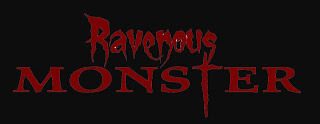
Published on March 24, 2013 11:23
March 21, 2013
Gothic Horror: The Fine Line Between the Formulaic and the Clichéd by Leigh M. Lane
Please Welcome to Cutis Anserina Leigh M. Lane
When the typical reader defines Gothic horror, often the person will mention Edgar Allan Poe, Mary Shelley, and dark castles enshrouded in fog and thunderstorms. Perhaps ravens and stylistic prose might fall into the mix. Some might even add in vampires, werewolves, or similar night-stalking beasts. When it comes right down to it, however, the term “Gothic” is rather vague to many people. Often, readers and writers alike will classify a work as being Gothic without really knowing what elements contribute to that classification. Moreover, some authors will use the term loosely when categorizing their works, filling them with timeworn clichés as opposed to actual Gothic essentials.
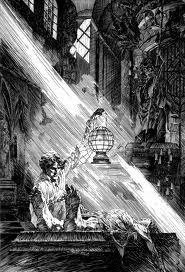
Obviously, Poe and Shelley are excellent examples of the Gothic genre, although many of their Gothic-classified works do not meet all of the criteria. Following are some examples of their works that genuinely are Gothic horrors:Frankenstein“The Mortal Immortal”“The Fall of the House of Usher”“The Masque of the Red Death”
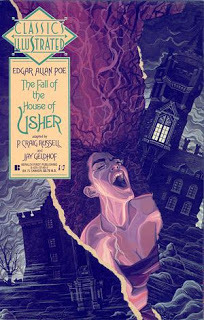
What these works have in common are uses—or relatable variations—of the essentials literary scholars agree must be included in the genre. Among these are a castle (although any large estate will do), a supernatural element, and an escape from some type of defined evil (which typically occurs through some type of maze, but can take place in any physically or emotionally binding location).Many people will define Gothic as nearly any story with dark themes, which is an incorrect interpretation of the genre. Bearing this in mind, consider a few other words that have been defined inappropriately as Gothic:“The Cask of Amontillado”“The Raven”“The Tell-Tale Heart”
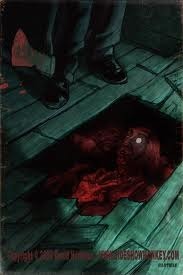
In the case of “The Cask of Amontillado,” one might compare the catacombs to a maze, although none of the characters escape any type of evil through it. The story is also absent of a castle, literally or metaphorically, and also contains no supernatural elements. Similarly, “The Raven” takes place in an unspecified location. Although set during a dark and stormy night, that is the only element readers can determine actually exists in the story. “The Tell-Tale Heart” is probably one of Poe’s most grossly ill-identified “Gothic” work. The story contains no castle, no supernatural element, no maze, and no dark or stormy backdrop. While it is one of Poe’s greatest works, it is not, under the conventional definition, Gothic.Unfortunately, many authors will attempt to write Gothic horrors by including a dark element, a stormy night, insanity, or a nice murder of ravens, and what they end up with is a clichéd attempt that falls short of meeting any of the actual criteria. By studying the genre and reading a vast array of actual Gothic works, writers can avoid such pitfalls.In my Gothic horror, Finding Poe, I use a combination of traditional elements to make the work true to its genre. Written with careful attention to Poe’s language, to story is a mindful tribute not only to Edgar Allan Poe, but to the genre he helped to popularize.
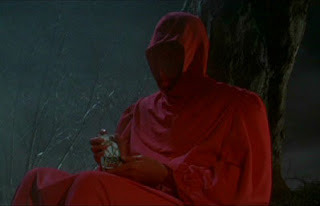
About Finding Poe:In the wake of her husband's haunted death, Karina must sift through the cryptic clues left behind in order to solve the mystery behind his suicide--all of which point back to the elusive man and author, Edgar Allan Poe. Karina soon finds that reality, dream, and nightmare have become fused into one as she journeys from a haunted lighthouse in New England to Baltimore, where the only man who might know the answers to her many questions resides. But will she find her answers before insanity rips her grip on reality for good? Might a man she's never met hold the only key to a truth more shocking than even she could have imagined?

About the author:Leigh M. Lane has been writing for over twenty years. She has ten published novels and twelve published short stories divided among different genre-specific pseudonyms. She is married to editor Thomas B. Lane, Jr. and currently resides in the beautiful mountains of western Montana. Her traditional Gothic horror novel, Finding Poe, was a finalist in the 2013 EPIC Awards in horror, and has also hit Amazon's paid bestseller list.Her other Leigh M. Lane novels include The Hidden Valley, inspired by Barker, Bradbury, and King, World-Mart, a tribute to Orwell, Serling, and Vonnegut, and the allegorical tale, Myths of Gods.For more information about Leigh M. Lane and her writing, visit her website at http://www.cerebralwriter.com.
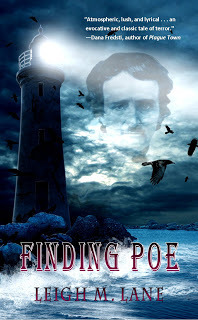
Published on March 21, 2013 16:08
March 20, 2013
Manhattan Grimoire by Sandy Deluca
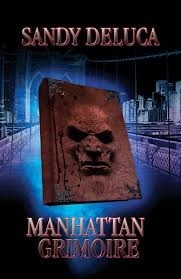
Sandy Deluca’s Manhattan Grimoire is masterpiece of balance between the grit and grime of our world, and menace that exists just beyond our perception. Deluca creates a sense of peril with nearly every word she writes, only to later reveal the truth is darker than our fears. Those searching for a dark horror novel with a tangible atmosphere would be hard pressed to find a better read.
Click Either Image for the full review at
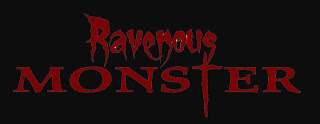
Published on March 20, 2013 17:17
March 19, 2013
It is pointless to cut The Evil Dead remake from its NC-17 Form
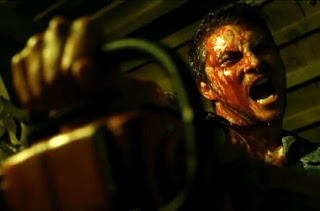
“…proud of scoring a NC17 when submitted! But we had to cut stuff out to get an R and get the film into theaters." Director of The Evil Dead Remake Fede Alvarez tweeted this on January 28th. Due to the simple realities of a studio film and contractual obligations the film will be cut down to what the MPAA deems to be acceptable for an R rating. There is no serious reason for these actions to take place.
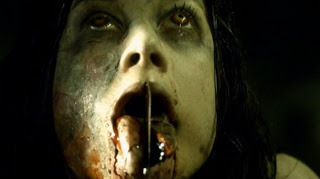
If we were truly serious about sheltering kids from this type of violent content we would as a society demand the film keep its NC-17 rating. This would reduce the number of kids from seeing the film. Instead we go through the predictable motions of feigning concern. The NC-17 version will be available as ‘unrated’ when The Evil Dead remake comes to DVD and streaming digital, so why bother? Hell, check out the red band trailer that any kids can see. (No really, its intense.) The system does not protect kids from content, and it no longer serves its original purpose of allowing an indicator that a film contains adult content, so that content does not have to be cut. Yet we keep the system, and the reason is simple.
It comes down to money, most theatre chains refuse to carry NC-17 films, and most networks and media outlets won’t sell advertisements for NC-17 films. Beyond seeing artists’ actual work and vision, utilization of the NC-17 would allow me personally to have better experiences when I go to the movies.
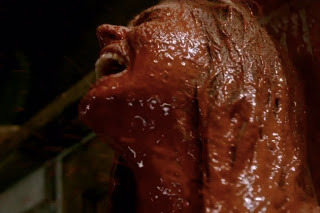
I really enjoy and still get excited about seeing movies on the big screen, in a dark room with my phone turned off. It is like a sanctuary where I can forget about everything outside for two hours and watch a story unfold. The only distraction should be the need to pee as the third act begins, though outside forces often seem hell-bent to ruin this for me. Like the three twelve year old girls, that based on their attire came straight from cheerleading practice when I went to see Rob Zombie’s Halloween. Or the parents that brought a kid in a carrier to the showing of Saw IV, or the parent who brought a kid to The Cell and when the raped, mutilated corpse was dragged out of the water asked, “Mommy, what’s that?” The R rating is not serving any purpose.
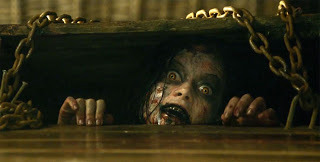
I will not be afforded an opportunity to see Fede Alvarez’s preferred vision of The Evil Dead in theatres, because a group of strangers based on secret criteria will not allow it. I have a problem with this because I was raised to think for myself, in a house where censorship, in whatever the form was considered the true obscenity. And a movie with demons possessing the living and needing to be hacked to pieces, is not appropriate for younger kids, regardless of how much blood is on screen.
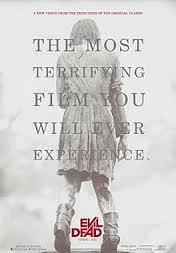
*Bonus fun fact, the average 12 year old has seen video of an un-simulated sex act.
Published on March 19, 2013 17:17
March 17, 2013
Mile 81 by Stephen King
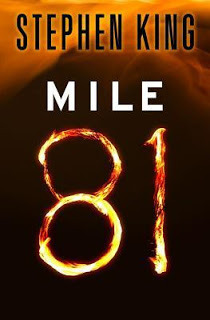
Mile 81 is a novella that plays to all of King’s strengths and trademarks. Pete Simmons is a foul mouthed kid living in Maine who stumbles across an unpleasant supernatural creature. The cast builds and shrinks pretty quickly and this may be one of King’s highest per page body counts as a plethora of well thought out and developed characters quickly become fodder for the dark creature.
This novella reminded me a great deal of IT with the kid’s investigative nature, trumping the evil. Though much like IT I found the final climax to be very disappointing. In the end there is much to like in Mile 81, yet a few glaring weaknesses.
Published on March 17, 2013 10:25
March 14, 2013
Naima Haviland reviews Where the Dead Fear to Tread
Naima Haviland author of Blood Room reviews Where the Dead Fear to Tread.
"I not only enjoyed Where the Dead Fear to Tread by M.R. Gott; I admired it. While the novel is squarely on the violent end of the horror genre spectrum, it blends elements of noir and action film genres into it. Also, Gott created unique and original versions of traditional horror monsters so the villains have motives and powers you won't expect. He added to that the very real human monsters we see all too often in the news. Then he invented new monsters out of his own sick mind (his dreams must be incredible). And he wrote the grossest way to die I've read in a long time, if ever.
Plot: William Chandler is a vigilante rescuing kidnapped children and killing the sex slavers who traffic in them. Kate Broadband is a cop who's working the same beat and is chaffing at the restrictions of going by the book. Each is seeking the same missing little girl. A mysterious woman promises to reveal where the girl is being kept –but first William must rescue a kidnapped boy held in a clinic that is a front for sex traffickers. That might be just another day's killing spree for William, except the clinic's interior is a supernatural realm.
Where the Dead Fear to Tread is graphically violent in descriptions of fights between adults (scenes with children are only descriptive enough for you to know what happened). But as the plot progresses we learn of William's earlier times and the emotional loss that drove him off the rails. The novel surprised me with this insight; it gave depth to the action. My stake in the plot twists and turns intensified.
If you like the stories of horror writer Lee Thompson, you'll like M.R. Gott. Both write of anti-heroes with nothing left to lose who prowl surreal and hellish landscapes on single-minded vendettas.
Where the Dead Fear to Tread is a high-octane thriller that packs a wicked punch and a killer bite (and a surprisingly soft heart)."
 Naima Haviland likes dead people. Fictional dead people, that is, and the twisted people who make them dead (or undead). She is the author of Bloodroom and Night at the Demontorium, a vampire novel and dark fantasy anthology for Kindle. She takes as inspiration the Southeast United States, including her home in the Florida Panhandle, an ocean paradise with a not-too-distant past full of eccentrics, explorers, pirates, ghosts, and UFOs.
Naima Haviland likes dead people. Fictional dead people, that is, and the twisted people who make them dead (or undead). She is the author of Bloodroom and Night at the Demontorium, a vampire novel and dark fantasy anthology for Kindle. She takes as inspiration the Southeast United States, including her home in the Florida Panhandle, an ocean paradise with a not-too-distant past full of eccentrics, explorers, pirates, ghosts, and UFOs.
"I not only enjoyed Where the Dead Fear to Tread by M.R. Gott; I admired it. While the novel is squarely on the violent end of the horror genre spectrum, it blends elements of noir and action film genres into it. Also, Gott created unique and original versions of traditional horror monsters so the villains have motives and powers you won't expect. He added to that the very real human monsters we see all too often in the news. Then he invented new monsters out of his own sick mind (his dreams must be incredible). And he wrote the grossest way to die I've read in a long time, if ever.
Plot: William Chandler is a vigilante rescuing kidnapped children and killing the sex slavers who traffic in them. Kate Broadband is a cop who's working the same beat and is chaffing at the restrictions of going by the book. Each is seeking the same missing little girl. A mysterious woman promises to reveal where the girl is being kept –but first William must rescue a kidnapped boy held in a clinic that is a front for sex traffickers. That might be just another day's killing spree for William, except the clinic's interior is a supernatural realm.
Where the Dead Fear to Tread is graphically violent in descriptions of fights between adults (scenes with children are only descriptive enough for you to know what happened). But as the plot progresses we learn of William's earlier times and the emotional loss that drove him off the rails. The novel surprised me with this insight; it gave depth to the action. My stake in the plot twists and turns intensified.
If you like the stories of horror writer Lee Thompson, you'll like M.R. Gott. Both write of anti-heroes with nothing left to lose who prowl surreal and hellish landscapes on single-minded vendettas.
Where the Dead Fear to Tread is a high-octane thriller that packs a wicked punch and a killer bite (and a surprisingly soft heart)."
 Naima Haviland likes dead people. Fictional dead people, that is, and the twisted people who make them dead (or undead). She is the author of Bloodroom and Night at the Demontorium, a vampire novel and dark fantasy anthology for Kindle. She takes as inspiration the Southeast United States, including her home in the Florida Panhandle, an ocean paradise with a not-too-distant past full of eccentrics, explorers, pirates, ghosts, and UFOs.
Naima Haviland likes dead people. Fictional dead people, that is, and the twisted people who make them dead (or undead). She is the author of Bloodroom and Night at the Demontorium, a vampire novel and dark fantasy anthology for Kindle. She takes as inspiration the Southeast United States, including her home in the Florida Panhandle, an ocean paradise with a not-too-distant past full of eccentrics, explorers, pirates, ghosts, and UFOs.
Published on March 14, 2013 19:03

